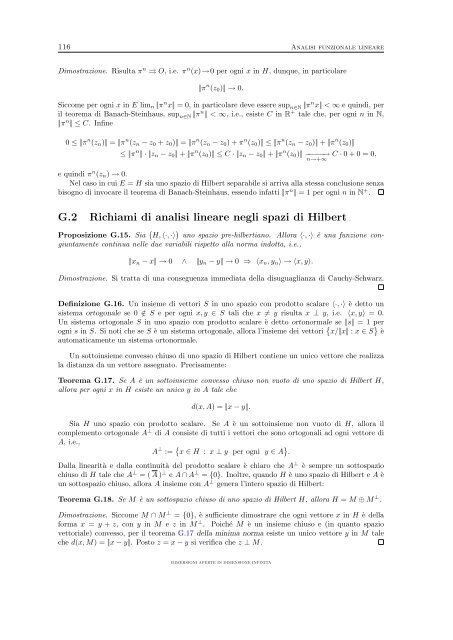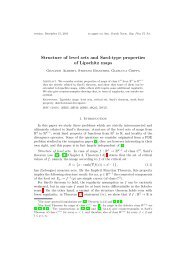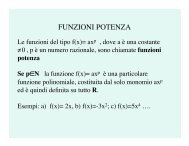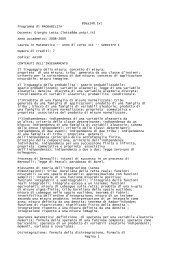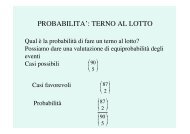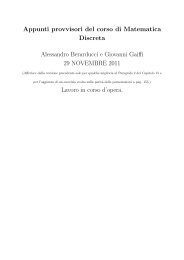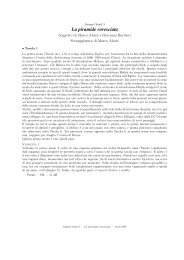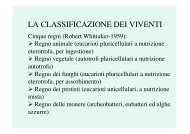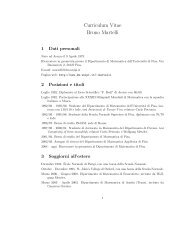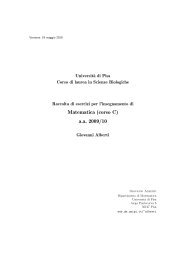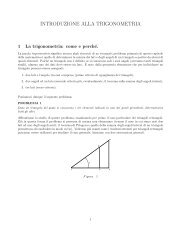Immersioni aperte in dimensione infinita - Dipartimento di Matematica
Immersioni aperte in dimensione infinita - Dipartimento di Matematica
Immersioni aperte in dimensione infinita - Dipartimento di Matematica
You also want an ePaper? Increase the reach of your titles
YUMPU automatically turns print PDFs into web optimized ePapers that Google loves.
116 Analisi funzionale l<strong>in</strong>eare<br />
Dimostrazione. Risulta π n ⇒ O, i.e. π n (x)→0 per ogni x <strong>in</strong> H, dunque, <strong>in</strong> particolare<br />
|π n (z0)| → 0.<br />
Siccome per ogni x <strong>in</strong> E limn |π n x| = 0, <strong>in</strong> particolare deve essere sup n∈N |π n x| < ∞ e qu<strong>in</strong><strong>di</strong>, per<br />
il teorema <strong>di</strong> Banach-Ste<strong>in</strong>haus, sup n∈N |π n | < ∞, i.e., esiste C <strong>in</strong> R + tale che, per ogni n <strong>in</strong> N,<br />
|π n | ≤ C. Inf<strong>in</strong>e<br />
0 ≤ ||π n (zn)| = |π n (zn − z0 + z0)| = |π n (zn − z0) + π n (z0)| ≤ |π n (zn − z0)| + |π n (z0)|<br />
≤ |π n | · |zn − z0 | + |π n (z0)| ≤ C · |zn − z0 | + |π n (z0)| −−−−−→<br />
n→+∞<br />
C · 0 + 0 = 0,<br />
e qu<strong>in</strong><strong>di</strong> π n (zn) → 0.<br />
Nel caso <strong>in</strong> cui E = H sia uno spazio <strong>di</strong> Hilbert separabile si arriva alla stessa conclusione senza<br />
bisogno <strong>di</strong> <strong>in</strong>vocare il teorema <strong>di</strong> Banach-Ste<strong>in</strong>haus, essendo <strong>in</strong>fatti |π n | = 1 per ogni n <strong>in</strong> N + .<br />
G.2 Richiami <strong>di</strong> analisi l<strong>in</strong>eare negli spazi <strong>di</strong> Hilbert<br />
Proposizione G.15. Sia H, 〈·, ·〉 uno spazio pre-hilbertiano. Allora 〈·, ·〉 è una funzione congiuntamente<br />
cont<strong>in</strong>ua nelle due variabili rispetto alla norma <strong>in</strong>dotta, i.e.,<br />
|xn − x| → 0 ∧ |yn − y | → 0 ⇒ 〈xn, yn〉 → 〈x, y〉.<br />
Dimostrazione. Si tratta <strong>di</strong> una conseguenza imme<strong>di</strong>ata della <strong>di</strong>suguaglianza <strong>di</strong> Cauchy-Schwarz.<br />
Def<strong>in</strong>izione G.16. Un <strong>in</strong>sieme <strong>di</strong> vettori S <strong>in</strong> uno spazio con prodotto scalare 〈·, ·〉 è detto un<br />
sistema ortogonale se 0 /∈ S e per ogni x, y ∈ S tali che x = y risulta x ⊥ y, i.e. 〈x, y〉 = 0.<br />
Un sistema ortogonale S <strong>in</strong> uno spazio con prodotto scalare è detto ortonormale se |s| = 1 per<br />
ogni s <strong>in</strong> S. Si noti che se S è un sistema ortogonale, allora l’<strong>in</strong>sieme dei vettori x/|x| : x ∈ S è<br />
automaticamente un sistema ortonormale.<br />
Un sotto<strong>in</strong>sieme convesso chiuso <strong>di</strong> uno spazio <strong>di</strong> Hilbert contiene un unico vettore che realizza<br />
la <strong>di</strong>stanza da un vettore assegnato. Precisamente:<br />
Teorema G.17. Se A è un sotto<strong>in</strong>sieme convesso chiuso non vuoto <strong>di</strong> uno spazio <strong>di</strong> Hilbert H,<br />
allora per ogni x <strong>in</strong> H esiste un unico y <strong>in</strong> A tale che<br />
d(x, A) = |x − y |.<br />
Sia H uno spazio con prodotto scalare. Se A è un sotto<strong>in</strong>sieme non vuoto <strong>di</strong> H, allora il<br />
complemento ortogonale A ⊥ <strong>di</strong> A consiste <strong>di</strong> tutti i vettori che sono ortogonali ad ogni vettore <strong>di</strong><br />
A, i.e.,<br />
A ⊥ := x ∈ H : x ⊥ y per ogni y ∈ A .<br />
Dalla l<strong>in</strong>earità e dalla cont<strong>in</strong>uità del prodotto scalare è chiaro che A ⊥ è sempre un sottospazio<br />
chiuso <strong>di</strong> H tale che A ⊥ = ( A ) ⊥ e A ∩ A ⊥ = {0}. Inoltre, quando H è uno spazio <strong>di</strong> Hilbert e A è<br />
un sottospazio chiuso, allora A <strong>in</strong>sieme con A ⊥ genera l’<strong>in</strong>tero spazio <strong>di</strong> Hilbert:<br />
Teorema G.18. Se M è un sottospazio chiuso <strong>di</strong> uno spazio <strong>di</strong> Hilbert H, allora H = M ⊕ M ⊥ .<br />
Dimostrazione. Siccome M ∩ M ⊥ = {0}, è sufficiente <strong>di</strong>mostrare che ogni vettore x <strong>in</strong> H è della<br />
forma x = y + z, con y <strong>in</strong> M e z <strong>in</strong> M ⊥ . Poiché M è un <strong>in</strong>sieme chiuso e (<strong>in</strong> quanto spazio<br />
vettoriale) convesso, per il teorema G.17 della m<strong>in</strong>ima norma esiste un unico vettore y <strong>in</strong> M tale<br />
che d(x, M) = |x − y |. Posto z = x − y si verifica che z ⊥ M.<br />
IMMERSIONI APERTE IN DIMENSIONE INFINITA


